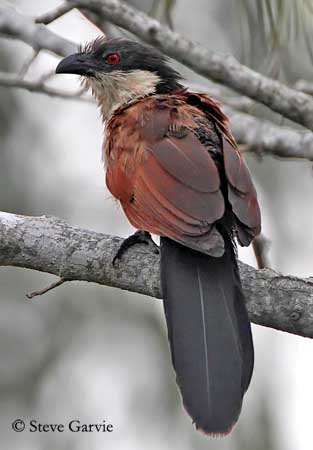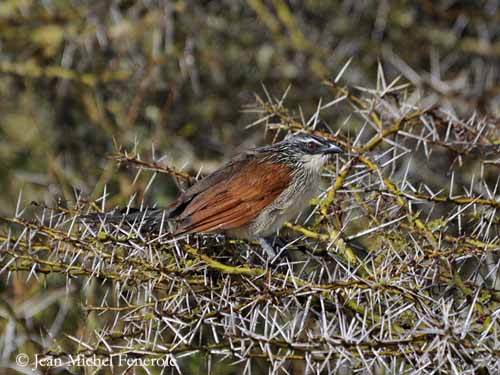
CUCULIDAE FAMILY
Subfamily Centropodinae
The subfamily Centropodinae includes 28-30 species with the unique genus Centropus. These birds are nest-building, non-parasitic cuckoos. They are the largest of the family with a length of 40-68 centimetres.
They frequent a wide variety of habitats such as lower montane rainforest, mangroves, thickets, bamboo and palm vegetation, primary and secondary forests, forest edges, scrub, dense jungle, and they occur generally in thick vegetated areas of all types.
They also frequent wet areas, as well mangroves and swamp forest, as ricefields, marshy reedbeds and grass, flooded grasslands, savannahs near water and dense riverine bush.
However, some species such as the Senegal Coucal (Centropus senegalensis) are less associated with wet areas than other African species.
The coucals can be seen from sea-level and lowlands to high elevations, between 500 and 1800/2100 metres and more according to the range.

Senegal Coucal
Centropus senegalensis
These heavy-bodied birds feed on large insects of numerous species, including large stick-insects (Phasmatodea), spiders, and also small invertebrates such as lizards, snakes, frogs, small birds and mammals.
The Greater Coucal (Centropus sinensis) also takes scorpions, crabs, snails, slugs, fruit and seeds.
The Blue-headed Coucal (Centropus monachus) is a generalist carnivore, feeding on large insects, snails, nestling birds and eggs, reptiles, frogs, mice and rats.

The Coppery-tailed Coucal (Centropus cupreicaudus) which frequents various wet areas feeds on fish and scavenges for dead fish too.
They usually forage on or near the ground and also at grass fires in Africa. Some of them are active in limbs of trees and vines, and clamber into thick vegetation.

Centropus cupreicaudus
They may forage in small groups, walking in low dense vegetation and ground cover.
They hop and run when pursuing a prey. They are slow and clumsy, but they move rapidly when the prey is located. In swampy areas, they feed partly in the water.
The Madagascar Coucal (Centropus toulou) feeds on the ground, usually in thick scrub. It chases the prey (grasshoppers and lizards) by “flush and rush”, and rips the bark of tree trunks to get the concealed lizards. This species often feeds in pairs.


Madagascar Coucal
Centropus toulou
Madagascar Coucal
Centropus toulou
The coucals have numerous calls often uttered in series. These sounds are more “noises” than calls or songs.
They usually give “sawing” or “snoring” noises, or deep, hollow booming notes, and low-pitched, resonant booming hoots “woop woop woop”.
The alarm calls are shorter, harsh, scold “skaaah” or hisses. The pairs often perform duets.
SOME SOUNDS BY XENO-CANTO
White-browed Coucal - Xeno-Canto
Lesser Coucal
Centropus bengalensis

White-browed Coucal
Centropus sinensis
During the breeding season, the coucals build large nests. These structures can be globular or domed with grass. They are often placed near the ground in tall grass and bushes. There is a side entrance.
The eggs are white and the female lay 2-3 eggs. Both sexes raise the young. The incubation may last about two weeks.
The nestlings have a hair-like covering of stiff down, which remains attached to the growing feathers’ tips. It falls off usually after the young bird fledges.

Burchell's Coucal
Centropus burchellii
They usually breed during the wet season. Polyandry occurs sometimes in coucals. The male performs most of nesting duties while the female is able to attract more than one male. In this instance, each male has a separate territory within the large area occupied by the female.

Bay Coucal
Centropus celebensis
The coucals are resident in their range. Some species such as the Greater Coucal may disperse occasionally with slow flight and alternating flaps and glides.
The Senegal Coucal is locally migratory in more arid areas.


Coppery-tailed Coucal - Centropus cupreicaudus
Senegal Coucal - Centropus senegalensis
Several coucal species are relatively common or locally common in their range, but some of them are currently considered near-threatened due to hunting and habitat destruction in SE Asia.


Burchell's Coucal - Centropus burchellii
White-browed Coucal - Centropus sinensis
The Sunda Coucal (Centropus nigrorufus) from Java is Vulnerable and occurs in fragmented small local populations.
The Black-hooded Coucal (Centropus streerii) is Critically Endangered with highly restricted range in Mindora (NC Philippines), due to the loss of the primary forest.
The Green-billed Coucal (Centropus chlororhynchos) from Sri Lanka, is Endangered due to habitat loss.

White-browed Coucal
Centropus sinensis
They are generally threatened by deforestation and degradation of the habitat, but these statuses are poorly known and research is required.

White-browed Coucal
Centropus sinensis
Photographers :
Didier Buysse
Vision d’Oiseaux
Jean Michel Fenerole
Photos d’Oiseaux du monde
Steve Garvie
RAINBIRDER Photo galleries
Ingo Waschkies
Bird Photography
Callie de Wet
GALLERY
Text by Nicole Bouglouan
Sources :
HANDBOOK OF THE BIRDS OF THE WORLD vol 4 by Josep del Hoyo-Andrew Elliott-Jordi Sargatal - Lynx Edicions - ISBN: 8487334229
L’ENCYCLOPEDIE MONDIALE DES OISEAUX - Dr Christopher M. Perrins - BORDAS - ISBN: 2040185607
BirdLife International (BirdLife International)
CREAGUS@Monterey Bay (Don Roberson)
Wikipedia, the free encyclopaedia